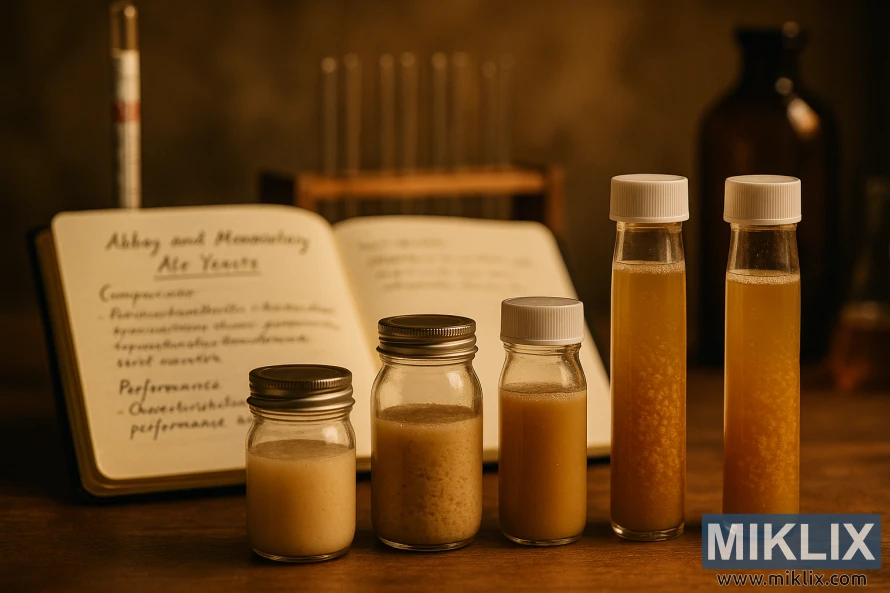Image: Abbey Yeast Still Life
Published: September 30, 2025 at 11:04:50 PM UTC
A warm still life shows jars and vials of Abbey ale yeasts with a blurred notebook and lab tools, blending brewing tradition and science.
The image captures a carefully staged still life arrangement, a tableau that feels equal parts scientific study and artistic meditation. At its heart, the composition revolves around the exploration of Abbey and Monastery Ale yeasts—those living agents of transformation that have shaped centuries of Belgian brewing tradition. Bathed in a warm, golden light, the scene communicates both the reverence of tradition and the meticulous curiosity of experimentation, blending the atmosphere of a monk’s study with the precision of a brewing laboratory.
In the foreground, occupying the most immediate visual plane, are five small glass containers—jars and slim vials—each filled with a different yeast culture. Their varying shades and consistencies highlight the diversity among strains. One jar is filled with a pale, creamy suspension, thick and smooth, while another reveals a dense, slightly granular sediment settled toward the bottom, its upper layer clearer, suggesting active flocculation. The vials, taller and more slender, contain cloudy, golden-brown liquids streaked with suspended yeast flocs, creating textures that resemble drifting constellations within amber-hued skies. Their sealed caps—some metallic, some plastic—underscore the practicality and sterility of laboratory work, yet the subtle irregularities of the yeast inside lend the containers a living, organic quality. Together, these jars and vials symbolize both order and mystery: controlled vessels of a process that resists complete predictability.
Immediately behind the yeast samples rests an open notebook, its two pages spread wide across the table. The paper bears handwritten notes and headings, though the text is intentionally softened, blurred just enough to deny precise legibility. Still, the suggestion of words like “Abbey and Monastery Ale Yeasts” and sections on “Comparison” or “Performance” give the impression of an ongoing inquiry, a brewer’s or researcher’s reflections captured in ink. The notebook introduces a human element: evidence of thought, reflection, and record-keeping. It bridges the tactile presence of the yeast samples with the intellectual framework that seeks to classify and understand them.
The middle and background are populated with subtle but significant details that reinforce the investigative atmosphere. A hydrometer stands upright, partially blurred but unmistakable in form, a tool for measuring the specific gravity of fermenting wort and a reminder of brewing’s scientific underpinnings. Behind it, a test tube rack holds several empty or lightly blurred tubes, their transparency catching highlights from the warm ambient light. These laboratory implements form a quiet backdrop, contextualizing the yeast samples not just as aesthetic subjects but as part of an active program of experimentation. To one side, the shadowed outline of a brown glass reagent bottle introduces a darker, grounding note, its old-fashioned pharmacy shape evoking both tradition and careful storage.
The entire arrangement is bathed in warm, golden light that fills the frame with a soft glow. The illumination highlights the textures of glass, liquid, and paper, while leaving the background in gentle shadow, creating depth and intimacy. The choice of lighting transforms what might have been a purely technical depiction into something almost monastic in tone, echoing the heritage of Trappist and Abbey brewing. It conjures the image of a scholar-monk or a brewer-scientist at work, recording observations late into the evening by lamplight, treating yeast not merely as an ingredient but as a subject of reverence and study.
Altogether, the scene exudes a sense of curiosity and discovery. It celebrates yeast as both scientific specimen and cultural treasure—tiny living cells that, through centuries of experimentation and observation, have come to define one of the world’s most iconic brewing traditions. The composition achieves a rare balance: it is investigative yet contemplative, technical yet poetic, modern yet deeply rooted in the timeless atmosphere of monastic brewing.
The image is related to: Fermenting Beer with White Labs WLP500 Monastery Ale Yeast

